Dermatology Practice Marketing Expert Services
A top-tier Dermatology Marketing Agency needs to balance medical accuracy with creative strategy — delivering compliant, patient-focused marketing that helps dermatology clinics grow sustainably.
The majority of dermatology practices treat patients for general treatment conditions, skin cancer surgery, acne treatment, actinic keratosis, cysts, moles, rashes, rosacea, and many other ailments.
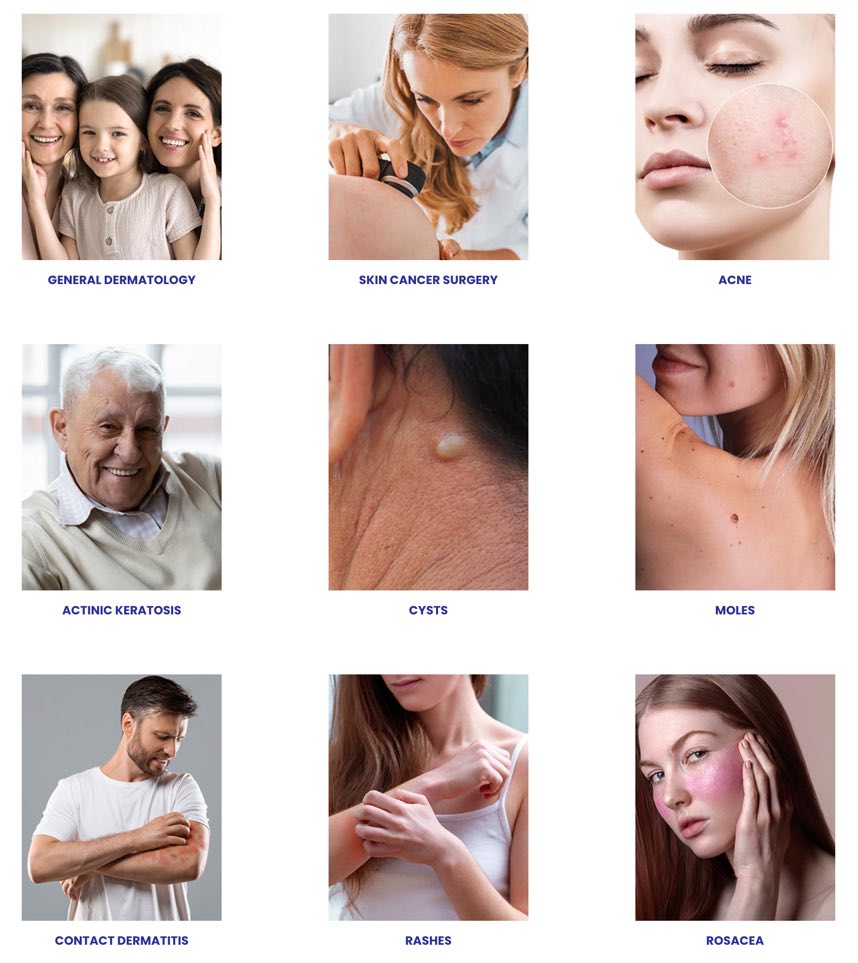
Some essential qualities and differentiators that define an effective agency in this niche:
1. Medical and Dermatology Industry Expertise
- Deep understanding of dermatological services such as acne treatment, cosmetic dermatology (Botox, fillers, laser), medical dermatology, and Mohs surgery.
- Knowledge of patient concerns (e.g., skin cancer prevention, anti-aging, psoriasis, eczema) and how to communicate them in compliant, empathetic language.
- Awareness of FDA and HIPAA marketing guidelines for medical advertising.
Example: A good agency knows that acne laser treatment ads must emphasize consultation and safety rather than guaranteed results — aligning with both compliance and patient trust.
2. HIPAA & Regulatory Compliance
They operate with a “compliance-first” mindset. They must have robust protocols for:
- Secure Data Handling: Ensuring all website forms, chatbots, and analytics tools filter out or securely handle Protected Health Information (PHI).
- Patient Consent: Knowing the legal requirements for showcasing before-and-after photos and video testimonials (explicit written patient consent is mandatory).
- Ad Language: Avoiding non-compliant, misleading, or unsubstantiated claims (e.g., “guaranteed cure”) in ad copy, which is strictly policed by search engines.
3. Dermatology SEO and Local Search Expertise
- Skilled in local SEO for dermatology clinics (ranking for terms like “skin doctor near me” or “acne treatment in [city]”).
- Ability to optimize for both cosmetic and medical intent — e.g., balancing “Botox specials” with “mole screening specialist.”
- Incorporates structured data, local listings, and review management to improve visibility on Google Maps and organic search.
4. Google Ads (PPC) and Paid Media Experience
- Expertise in managing medical PPC campaigns that comply with Google’s healthcare advertising policies.
- Expertise in conversion leads funnel for high-conversion services (e.g., laser resurfacing, skin rejuvenation) while minimizing cost-per-acquisition (CPA).
- Uses conversion tracking, call tracking, and landing page optimization to ensure ROI.
Example: A skilled agency knows not to overpromise “permanent results” in ad copy, keeping messaging compliant yet persuasive.
5. Content Marketing and Education Strategy
- Develops trust-based educational content such as service pages, FAQs, and procedure guides to boost authority.
- Utilizes AI-assisted tools (carefully supervised by human experts) to generate compliant, medically accurate material.
- Integrates dermatologist bios, before-and-after galleries, and patient success stories to increase conversions.
6. Reputation and Review Management
- Provides reviews app to strengthen reputation and attract more local patients.
- Provides HIPAA-safe systems for automating review requests after appointments.
- Implements technology to help practices easily communicate and ask for reviews.
7. High-Converting Medical Website Design
- Focuses on mobile-optimized, patient-friendly designs with clear calls to action specific app like SPOC app from PatientGain.
- Incorporates strong visuals — skin treatment results, dermatologist portraits, and video testimonials — to increase engagement.
- Uses accessibility standards (ADA compliance) to make sites inclusive and legally sound.
8. Analytics and Conversion Tracking
- Healthcare conversion tracking with proper patient consent and disclosures to any patient who contacts your healthcare practice. Many tracking apps like Google Tag manager and Meta pixels are NOT HIPPA COMPLIANT, as of 2025.
- Provides dashboards showing appointment bookings, phone calls, and form submissions from every marketing channel.
- Analyzes data to adjust ad spend, keyword strategy, and page performance for continuous improvement.
9. Social Media Posting App for Healthcare Practices
- Assists with cohesive social media strategies across Instagram, YouTube, and Facebook for visual storytelling.
- Assists with short-form videos showcasing dermatologist expertise or explaining procedures like microneedling and PRP.
- Assists with consistency in tone, aesthetics, and branding across platforms to strengthen recognition.
10. Transparent Pricing and Reporting
- Offers clear monthly reports on ROI, conversions, and ad spend. For example, PatientGain example: Initial consultation:
Before providing complete pricing details, PatientGain conducts an initial Zoom meeting to assess if the services are a good fit, and after that meeting, they will provide complete pricing information, including any extra charges and setup costs. - Provides strategic recommendations based on data, not just vanity metrics like clicks or impressions.
How PatientGain.com Can Help Market Your Dermatology Practice Using PLATINUM Service
Marketing companies for dermatology practices focus on new patient acquisition, marketing automation, including website creation, optimization, SEO, online advertising, and AI agents, with the goal of increasing patient volume and generating leads. They offer a comprehensive suite of applications and services for dermatology practices, including a platform for managing patient engagement and communication.
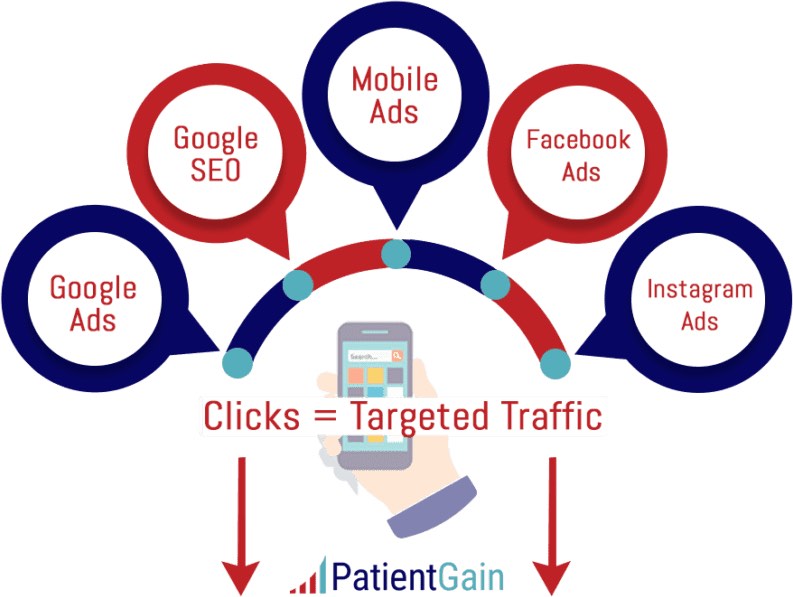
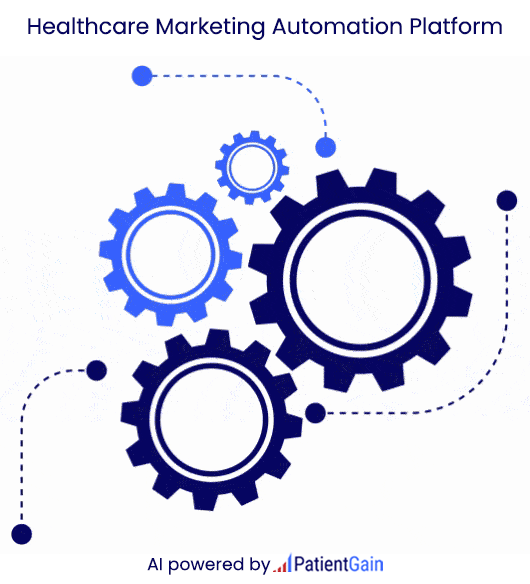
Dermatology practice marketing involves strategies to attract new patients to a skin care clinic by utilizing online platforms like Google advertising, posting on social media atleast 20 times per month, search engine optimization (SEO), targeted advertising, email campaigns, local community engagement, and patient testimonials to showcase the expertise of the dermatologists and the services offered, often focusing on preventative care and cosmetic procedures. Marketing companies, such as PatientGain, can significantly boost new patient growth for dermatology practices by combining advanced digital marketing strategies with specialized tools tailored for healthcare.

There is also a growing trend that more and more dermatology practices are growing their practices in aesthetics services, like botox, laser treatments, chemical peels, dermal fillers, laser hair removal, IPL photofacial, hydrafacials, sclerotherapy and many more cash-pay services.
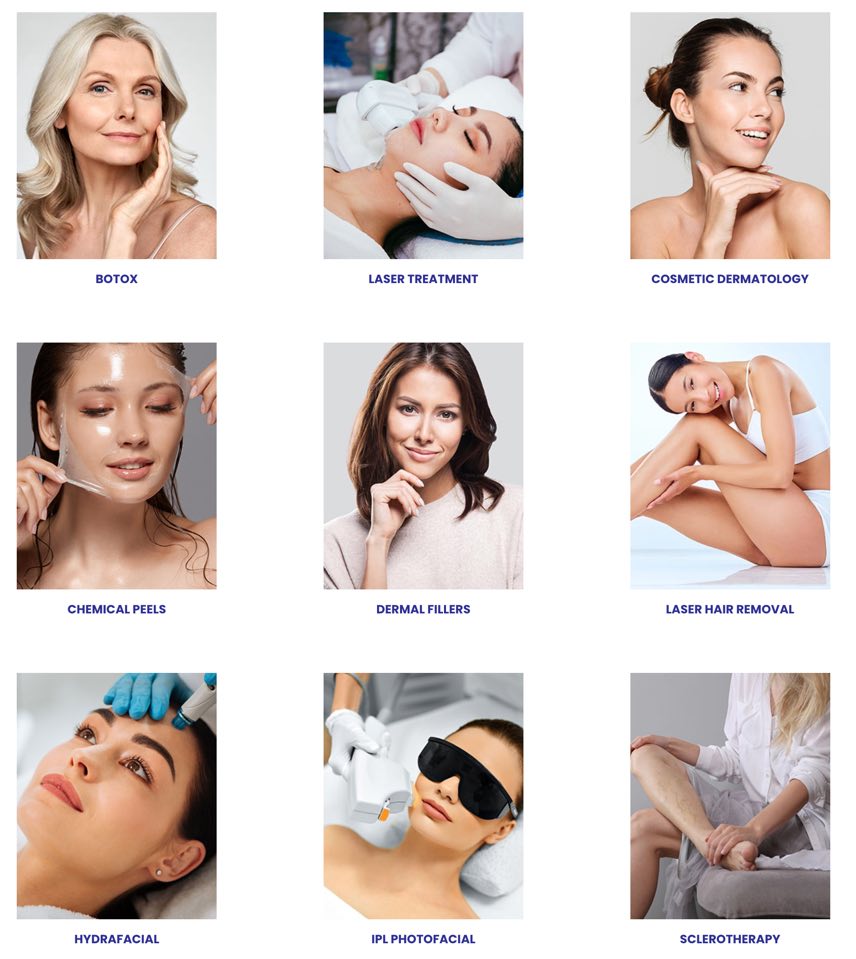
Some important strategies and services offered by PatientGain
AI-Powered Website & SEO Optimization
A well-optimized, high-converting website is the foundation of your marketing success. PatientGain’s AI-powered website solutions ensure that your clinic appears at the top of search engine results while providing an elegant user experience. SEO is a long term strategy and takes time to see results, however it is extremely profitable.
How PatientGain Helps: AI-Optimized Website Design – Modern, mobile-friendly, and high conversion websites. High performance SEO Optimization – AI strategy updates meta descriptions, keywords, and page structure to rank higher on Google. Voice Search & Local SEO – Optimized for searches like “Best dermatologist near me” or “Microneedling for acne scars in [city]”.
Example of high conversion rate PLATINUM customer offering dermatology and aesthetics, and spider vein treatments. In the month of Jan there are 3512 patients who visited the website. PatientGain’s software removes bots and this is actual human beings visiting the website. Out of 3512 patients, 796 patients contacted the practice using SMS/Texting, Contact Us, Appointments and Calling the practice. The call data is only those patients who clicked on “New Patient” option in the call tracking app. So this means that the conversion rate from this website is 22.67% in the month of January. See dashboard below.
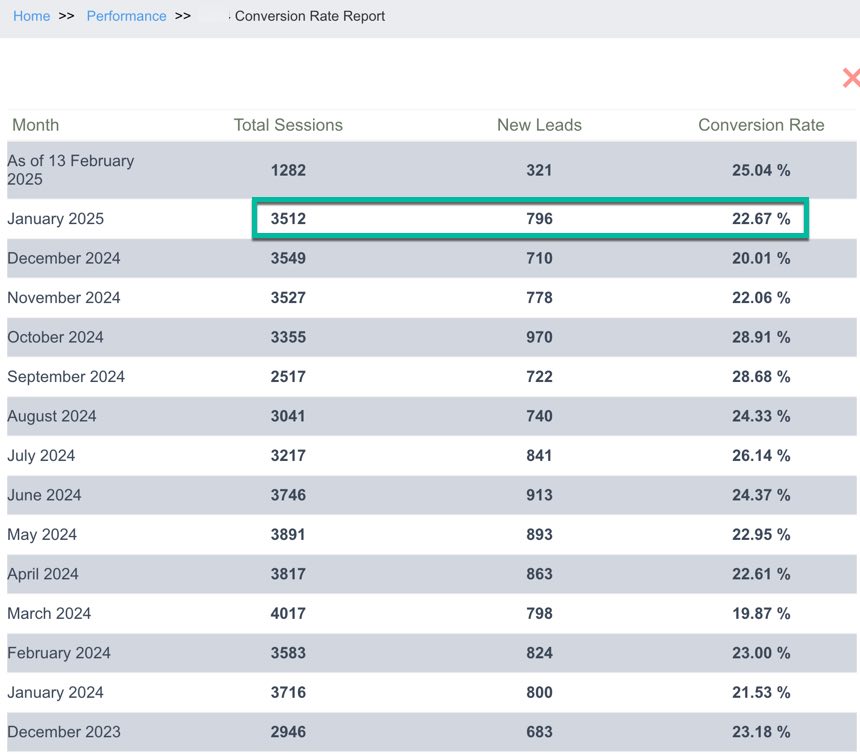
1. SEO and Local Search Optimization
Marketing companies focus on local SEO to ensure dermatology practices rank highly in search results for keywords like “dermatologist near me” or “acne treatment in [city].” For example, PatientGain offers human experts and AI-based medical SEO for dermatologists that provides monthly content updates and technical optimizations, improving search visibility for practices. By using location-based keywords and optimizing for voice search, practices can target local patients actively seeking dermatological services.
Example: A dermatology clinic in San Diego may see improved visibility for searches like “pediatric dermatologist in San Diego” after optimizing their website using PatientGain’s apps, which focus on geo-targeted SEO and local search. This drives more local traffic and increases bookings.
2. Content Marketing and Service Pages
Content marketing for dermatologist website is essential for patient education and SEO. Marketing agencies and platforms like PatientGain create regular content pages that focus on conditions, treatments and FAQs that address common concerns, such as acne, aging skin, or treatment options. These content pages not only inform potential patients but also improve rankings on Google, leading to more organic traffic.
Example: A content page titled “How to Prevent Wrinkles” or “Best Acne Treatment Options” can rank highly in search results. PatientGain helps dermatology practices create SEO-optimized content that attracts visitors who are more likely to convert into patients. They also leverage AI-powered content to ensure ongoing optimization.
3. Pay-Per-Click (PPC) Advertising
PPC advertising through platforms like Google Ads is an effective way to attract new patients. PatientGain creates, optimizes and manages Google PPC campaigns tailored to the dermatology practice’s specific services, such as Botox or skin cancer screening, ensuring they reach individuals actively searching for these treatments.
Example: A Chicago-based dermatology clinic may run a targeted Google Ads campaign focusing on “Botox near me,” driving traffic to a dedicated landing page. By using geo-targeted ads and remarketing strategies, PatientGain optimizes campaigns so the practice gets more qualified leads, resulting in higher conversion rates.
4. Social Media Marketing
Social media marketing for dermatologists is a powerful tool for patient engagement and brand building. PatientGain helps dermatology practices develop social media strategies, running campaigns that showcase before-and-after results, patient testimonials, and special offers. By leveraging platforms like Instagram, TikTok, and Facebook, they help practices visually showcase treatments and attract new patients.
Example: A Miami dermatology practice could partner with local influencers to showcase treatment results like acne scarring or skin resurfacing. PatientGain manages campaigns, ensuring the practice reaches a wider audience and converts social media followers into loyal patients.
5. Reputation Management
PatientGain’s Reputation Management app has been extremely effective in assisting dermatology practices with managing their online reputation by ensuring positive reviews are generated and addressing negative feedback professionally. Managing reviews on platforms like Google, Yelp, and Healthgrades can build trust with potential patients and influence their decision to choose a particular practice.
Example: A dermatology practice in Los Angeles could see a significant increase in patient bookings if they consistently maintain a high rating on Google Reviews. PatientGain’s app facilitates this by encouraging satisfied patients to leave positive reviews, making it easier for new patients to find and trust the clinic.
6. Email Marketing
Email marketing for dermatology practices is essential for keeping current patients engaged and informed about new treatments, upcoming appointments, or promotions. PatientGain’s Email marketing includes the app, and service. It is also integrated with HIPAA compliant CRM that keeps the patient’s Emails information in its secure database. This service is also used to retain patients by sending automated appointment Emails, birthday discounts, and seasonal skincare tips. PLATINUM service includes up to 3 campaigns per month. All work is done for you, all you have to do is to review the campaigns and click on “approve”.
Example: A practice in New York could send a personalized email to a patient-list of “mothers” for mothers day, reminding them about an annual skin check-up. The email could include special offers, like discounts on a new anti-aging treatment. This type of personalized follow-up increases patient retention and encourages them to book additional services.
7. Website Development and Optimization
A well-designed, user-friendly website is crucial for patient conversion. PatientGain creates, optimizes and maintains dermatology practices HIPAA-compliant websites. PatientGain dermatology websites are optimized for mobile devices, ADA compliance, and speed. This ensures that potential patients can easily navigate the site, learn about services, and book appointments.
Example: A Los Angeles dermatology clinic may see an increase in online bookings after optimizing its website with PatientGain’s platform, which includes mobile-friendly design, fast loading times, and easy-to-navigate appointment booking forms.
8. Video Marketing
Video marketing allows dermatology practices to connect with potential patients in a more personal and engaging way. PatientGain’s offers video app optimizes conversion using strategies that showcase treatments, patient testimonials, and expert advice from dermatologists, all of which help build trust.
Example: A dermatology practice in Miami could use PatientGain’s video offers app with an offer for a cash-pay patient for chemical peel and showcasing the results. By sharing this video on platforms like Instagram, Facebook, and YouTube, the practice can attract a wider audience, educate potential patients, and drive conversions.
9. AI-Based Lead Conversion and Patient Communication
PatientGain’s platform uses AI to improve lead conversion and patient communication. These tools capture leads through forms, chatbots, and automated appointment reminders. The AI system ensures that leads are nurtured effectively, ultimately converting them into paying patients.
Example: A practice in San Francisco may use PatientGain’s AI-powered platform to automatically follow up with leads who have shown interest in laser treatments, offering additional information and prompting them to book consultations. PatientGain’s AI app is also used to create SEO pages that rank very high on Google search.
10. Leads Funnel App
The PatientGain Leads Funnel App is a powerful tool designed to help healthcare practices, including dermatology clinics, capture, manage, and convert patient leads into appointments. The app is a part of PatientGain’s Platinum Service and works by streamlining the patient acquisition process, ensuring that potential patients who express interest are effectively nurtured and guided through the journey to becoming active clients.
Example: A Houston dermatology practice may use the leads funnel app for lead segmentation
All leads are automatically captured in the PatientGain’s leads-funnel app. Once the leads are captured, the PatientGain app automatically segments them based on key factors or the dermatology practice may decide to allocate them manually. Examples include : Service interest: Whether a person is interested in Botox, acne treatment, or a different dermatology service. Urgency: Determining if the lead is ready to book an appointment soon or if they need more nurturing over time. Patient demographics: Collecting data on the lead’s location, age, or other factors to further personalize the marketing efforts.

Google Ads & Social Media Advertising
Paid advertising is essential for attracting new patients fast, and PatientGain manages your Google Ads, Facebook Ads, and Instagram Ads.
How PatientGain Helps: Google Search Ads – Run high-intent ads targeting phrases like “Botox dermatologist near me” or “best filler for lip augmentation.” Reviewing campaign data by adwords certified team. Facebook & Instagram ads are also effective for dermatology practices. Your advertising budget is totally flexible and you can increase, decrease or stop the campaigns as you like. However we follow best practices to help you get good ROI from your advertising.
Chatbots & Automated Conversions
Many potential patients browse your website but never take action. AI-powered chatbots from PatientGain engage visitors instantly, answer their questions, and book consultations 24/7. The ChatBot guides patients in booking, directions, hours of operations and general question. Result is that a patient can get answers quickly, and all interactions are stoored in a a HIPAA compliant CRM and leads funnel.
Reputation Management & AI-Driven Review Collection
90% of patients check online reviews before booking a cosmetic procedure. PatientGain’s reputation management app helps you maximize positive reviews and minimize negative reviews. For example a medical practice in Seattle WA area, has been using PatientGain’s review management app and increased their Google rating from 3.8 to 4.6 stars within 8 months.
AI-Optimized Social Media Posting App
A strong Instagram, Facebook and GMB Posting presence helps cosmetic dermatologists attract younger, high-value clients.
How PatientGain Helps: AI-Generated Content Ideas – Weekly social media post suggestions & trending hashtags. Automated Post Scheduling – AI ensures consistent, high-quality social media engagement. Example: A dermatology practice in NYC uses PLATINUM service and 20 posts for GMB, 20 for Facebook and 20 for IG are created per month for this practice as a part of the monthly PLATINUM Service.
Email Marketing for Patient Engagement
PLATINUM service includes email marketing of up to 3 campaigns per month and helps bring patients back for repeat treatments.
Example 1: A monthly campaign offering VIP Hydra-facial Memberships
Example 2: VIP Event Marketing & Exclusive Launches
Loyalty & Referral Program Automation
Rewards and Loyalty programs increase repeat visits and encourage referrals. Many medical spas, aesthetics and dermatology practices employ loyalty marketing and referrals marketing to retain clients and patients in their business. Loyalty marketing is a great way to increase the value of a med spa’s conversions and can effectively maintain a patient count. A med spa and aesthetics practice can benefit from understanding how this marketing strategy works and how to use it effectively. There are more than 20,022 medical, health, and wellness spas in the United States, a med spa needs every tool available to succeed. PatientGain sets up the rewards and referrals app for you. You simply need make sure you respond to the leads and check your mobile phone for alerts. Patient rewards app for doctor offices is also suitable for other cash-pay medical practices, like IV therapy, medical weight loss, plastic surgeons, hormone clinics, dermatology and integrative practices.
Medical vs. Cosmetic Dermatology Marketing: Key Differences & Strategies: A softer, aspirational tone works better for cosmetic services, while a more clinical, expertise-driven approach is effective for medical dermatology.
Marketing for medical dermatology and cosmetic dermatology requires different approaches, as they serve distinct patient needs. While medical dermatology focuses on diagnosing and treating skin diseases, cosmetic dermatology aims to enhance skin appearance through elective procedures. Below is a detailed comparison of marketing strategies tailored for each specialty. Medical dermatology patients seek treatment for conditions like acne, eczema, psoriasis, rosacea, or skin cancer, and these treatments are often covered by insurance. Cosmetic dermatology patients look for elective procedures such as Botox, fillers, laser treatments, and skin rejuvenation, which are typically paid out-of-pocket. Marketing should clearly define who the services are for and adjust messaging to match their motivations—relief from skin conditions versus aesthetic enhancement.
Branding and messaging should align with the focus of each specialty. Medical dermatology marketing should emphasize expertise, trust, and medical authority with messaging centered on patient education and symptom relief. An example would be: “Board-certified dermatologists providing advanced treatment for acne, eczema, and skin cancer screenings.” Cosmetic dermatology marketing should highlight beauty, confidence, and luxury, using aesthetic visuals and aspirational messaging. An example would be: “Achieve flawless, youthful skin with our advanced cosmetic dermatology treatments.” A softer, aspirational tone works better for cosmetic services, while a more clinical, expertise-driven approach is effective for medical dermatology.
Website design should reflect the nature of the practice. A medical dermatology website should highlight treatment options, insurance information, doctor credentials, and patient education blogs. A cosmetic dermatology website should focus on before-and-after photos, service pricing, membership options, and patient testimonials. AI-powered chatbots and appointment booking tools can enhance engagement on both types of websites.
Search engine optimization (SEO) strategies also differ. Medical dermatology SEO should focus on informational searches like “best dermatologist for acne treatment” or “skin cancer screening near me.” Cosmetic dermatology SEO should target service-related searches like “best Botox clinic near me” or “microneedling for acne scars.” AI-powered SEO tools like PatientGain can help rank for high-intent patient searches.
Social media marketing varies between the two specialties. Medical dermatology social media should focus on educational content, explaining common skin conditions, treatment options, and prevention tips. Cosmetic dermatology social media should feature before-and-after transformations, beauty trends, patient testimonials, and live procedure demos on Instagram and TikTok. Instagram Reels and TikTok videos are ideal for cosmetic dermatology, while Facebook and LinkedIn work better for medical dermatology.
Pay-per-click (PPC) advertising should be tailored to patient needs. Medical dermatology PPC should target treatment-based queries like “dermatologist for eczema near me” or “mole removal specialist.” Cosmetic dermatology PPC should focus on high-value treatments like “lip fillers special $499” or “Laser skin tightening—book a consultation today.” AI-driven ads work well for cosmetic dermatology, compare different ads here.
Reputation management is critical for both fields but requires different approaches. Medical dermatology reviews focus on expertise, professionalism, and successful medical treatments, while cosmetic dermatology reviews highlight results, appearance, and customer experience (e.g., “natural-looking Botox results”). Automating review requests via AI-powered email and SMS follow-ups can help maintain a five-star online reputation.
Pricing and membership marketing play a bigger role in cosmetic dermatology. Medical dermatology pricing is often covered by insurance, so pricing transparency is less critical. Cosmetic dermatology patients pay out-of-pocket, making transparent pricing, financing options, and VIP memberships essential. Offering loyalty programs, treatment packages, and referral incentives encourages repeat visits in cosmetic dermatology.
Email and SMS marketing should be used differently for each specialty. Medical dermatology should send reminders for follow-ups, annual skin checks, and patient education newsletters. Cosmetic dermatology should use seasonal promotions, birthday discounts, and VIP membership perks to encourage repeat visits. Automating email and SMS campaigns with AI-powered marketing tools from PatientGain ensures consistent patient engagement.
Community engagement strategies also differ. Medical dermatology practices benefit from partnerships with hospitals, primary care physicians, and insurance providers for patient referrals. Cosmetic dermatology clinics should collaborate with medspas, beauty influencers, and local salons for cross-promotions. Hosting educational skin health seminars for medical dermatology and VIP beauty events for cosmetic dermatology helps attract targeted patients.
Traditional marketing tactics such as print advertising, direct mail campaigns, and event sponsorships can be useful for both specialties. Medical dermatologists may advertise in medical journals or health magazines, while cosmetic dermatologists may place ads in beauty and lifestyle publications.
Tracking and analyzing marketing performance is essential to optimizing results. Using Google Analytics to monitor website traffic and conversions, analyzing Google My Business insights, and leveraging AI-driven marketing dashboards can help improve marketing ROI. A dermatology practice using AI-powered analytics from PatientGain increased conversion rates by 50% in six months.
Staying updated on industry trends ensures a competitive advantage. New dermatological treatments like Morpheus8 RF Microneedling, PRP therapy, and AI-driven skincare recommendations can attract patients. Keeping up with Google’s SEO updates helps maintain high rankings, and emerging platforms like TikTok provide new opportunities for skincare education and patient engagement.
Marketing a dermatology practice can be time-consuming, and working with a specialized healthcare marketing agency ensures maximum patient growth. AI-driven marketing platforms like PatientGain offer comprehensive, automated marketing solutions, expert-designed social media campaigns, AI-powered SEO, and paid advertising strategies tailored for dermatology practices. A dermatology clinic partnered with PatientGain’s AI-powered marketing services and saw a 47% increase in monthly patient appointments within six months.
To successfully market a dermatology practice, use AI-powered SEO and PPC ads to target the right patient search intent, leverage social media differently—education for medical, aesthetics-driven content for cosmetic, offer membership programs and loyalty rewards for cosmetic dermatology patients, and automate patient engagement, reviews, and marketing campaigns with AI-driven platforms like PatientGain.
Examples of Patient Education & Symptom Relief Content for Medical Dermatology Websites
Medical dermatology websites should provide valuable patient education to establish trust, answer common concerns, and guide patients toward proper treatment. Below are effective content examples focused on symptom relief, treatment options, and prevention strategies for various skin conditions.
1. Acne Treatment & Symptom Relief
Content Page Topic: “Understanding Acne: Causes, Symptoms, and Effective Treatments”
- Symptoms Explained: Redness, pimples, blackheads, whiteheads, and cystic acne.
- Educational Content: Causes like hormonal changes, bacteria, clogged pores, and diet.
- Symptom Relief Tips:
- Use gentle cleansers and non-comedogenic products.
- Avoid touching or popping pimples to prevent scarring.
- Consider prescription treatments like retinoids or oral antibiotics.
- Call-to-Action (CTA): “Struggling with persistent acne? Book a consultation with our dermatologists for a customized acne treatment plan.”
2. Eczema & Atopic Dermatitis
Content Page Topic: “Eczema: How to Soothe Dry, Itchy Skin and Prevent Flare-Ups”
- Symptoms Explained: Dry, inflamed, itchy, and red skin that worsens with triggers.
- Educational Content: Common triggers like allergens, stress, soaps, and weather changes.
- Symptom Relief Tips:
- Apply fragrance-free moisturizers immediately after showering.
- Avoid hot showers and harsh soaps.
- Use prescription creams or biologic medications for severe cases.
- CTA: “Get relief from eczema—schedule an appointment to discuss treatment options today.”
3. Psoriasis Treatment & Relief
Content Page Topic: “Living with Psoriasis: Treatment Options for Long-Term Symptom Relief”
- Symptoms Explained: Scaly, itchy patches on the scalp, elbows, and knees.
- Educational Content: Psoriasis is an autoimmune condition that causes rapid skin cell turnover.
- Symptom Relief Tips:
- Use medicated shampoos or coal tar treatments for scalp psoriasis.
- Consider phototherapy (light therapy) for persistent flare-ups.
- Discuss biologic therapy options for moderate-to-severe cases.
- CTA: “Find the right psoriasis treatment for your skin—consult our dermatology experts today.”
4. Skin Cancer Awareness & Prevention
Content Page Topic: “How to Detect Skin Cancer Early: Signs & When to See a Dermatologist”
- Symptoms Explained: Asymmetry, irregular borders, uneven color, or growing moles (ABCDE rule).
- Educational Content: Skin cancer types—basal cell carcinoma, squamous cell carcinoma, and melanoma.
- Prevention & Relief Tips:
- Apply broad-spectrum SPF 30+ sunscreen daily.
- Wear protective clothing and avoid peak sun hours.
- Schedule annual skin checks for early detection.
- CTA: “Concerned about a suspicious mole? Book a skin cancer screening today.”
5. Rosacea Management & Skincare Tips
Content Page Topic: “Managing Rosacea: How to Reduce Redness and Flare-Ups”
- Symptoms Explained: Persistent facial redness, visible blood vessels, and acne-like breakouts.
- Educational Content: Common triggers—hot drinks, spicy foods, alcohol, stress, and sun exposure.
- Symptom Relief Tips:
- Use gentle, fragrance-free skincare products.
- Avoid extreme temperatures and spicy foods.
- Consider laser therapy for long-term redness reduction.
- CTA: “Personalized rosacea treatment plans available—schedule a consultation today.”
6. Warts & HPV Treatment
Content Page Topic: “Wart Removal: When to See a Dermatologist for Treatment”
- Symptoms Explained: Small, rough growths on hands, feet, or genital areas caused by HPV (human papillomavirus).
- Educational Content: Types of warts—common, plantar, flat, and genital warts.
- Symptom Relief Tips:
- Use over-the-counter salicylic acid treatments for common warts.
- Schedule cryotherapy (freezing therapy) or laser treatments for persistent warts.
- Boost immune function to prevent recurrence.
- CTA: “Need expert wart removal? Schedule an appointment with our dermatology specialists.”
7. Hair Loss & Scalp Health
Content Page Topic: “Hair Thinning? Causes and Treatments for Hair Loss”
- Symptoms Explained: Gradual hair thinning, bald patches, or excessive shedding.
- Educational Content: Causes—genetics, hormonal changes, stress, and nutritional deficiencies.
- Symptom Relief Tips:
- Consider topical minoxidil (Rogaine) or oral finasteride.
- Eat a balanced diet rich in iron, biotin, and protein.
- Explore PRP therapy or hair transplant options.
- CTA: “Regain your confidence—learn about our advanced hair restoration treatments today.”
8. Hives & Allergic Skin Reactions
Content Page Topic: “Why Do I Get Hives? Causes, Treatments, and When to See a Dermatologist”
- Symptoms Explained: Raised, itchy, red welts that appear suddenly.
- Educational Content: Common causes—food allergies, medications, insect bites, stress, and infections.
- Symptom Relief Tips:
- Take antihistamines to reduce itching.
- Avoid triggers like certain foods or temperature extremes.
- Seek prescription treatments for chronic hives.
- CTA: “Experiencing frequent hives? Consult our dermatologists for expert care.”
9. Hyperpigmentation & Melasma Treatments
Content Page Topic: “How to Get Rid of Dark Spots and Uneven Skin Tone”
- Symptoms Explained: Brown or gray patches on the face due to sun exposure, pregnancy, or hormonal changes.
- Educational Content: Difference between melasma, sun spots, and post-inflammatory hyperpigmentation (PIH).
- Symptom Relief Tips:
- Apply broad-spectrum sunscreen daily to prevent further darkening.
- Use topical treatments like hydroquinone, retinoids, and vitamin C serums.
- Consider chemical peels or laser treatments for deep pigmentation.
- CTA: “Discover effective hyperpigmentation treatments—schedule a consultation today.”
10. Athlete’s Foot & Fungal Infections
Content Page Topic: “How to Treat and Prevent Athlete’s Foot”
- Symptoms Explained: Itchy, scaly, red, and cracked skin between the toes.
- Educational Content: Fungal infections thrive in warm, moist environments like gyms and locker rooms.
- Symptom Relief Tips:
- Keep feet dry and wear moisture-wicking socks.
- Use over-the-counter antifungal creams or powders.
- Seek prescription-strength treatments for severe cases.
- CTA: “Recurring athlete’s foot? Get expert treatment from our dermatologists today.”
Providing valuable educational content on your medical dermatology website helps establish trust, improve patient engagement, and guide individuals toward the right treatments. By offering symptom relief tips, prevention strategies, and expert guidance, you can attract new patients and retain existing ones.
PatientGain.com is an AI-powered marketing platform designed specifically for healthcare and aesthetic practices like cosmetic dermatology clinics. By using AI-driven SEO, digital advertising, reputation management, and patient engagement tools, PatientGain helps attract, convert, and retain high-value patients. Below is an in-depth look at how PatientGain.com can optimize every aspect of your marketing strategy.
Contact us and book a presentation so we can share many examples with you.
